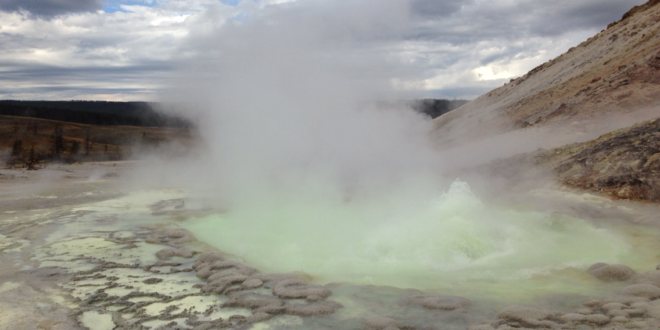Using a virus taken from a hot spring in the Crater Hills area of Yellowstone National Park, researchers in Virginia hope to revolutionize cancer treatment.
According to a press release, researchers at the University of Virginia have isolated the virus’ secret of indestructibility by analyzing its shape at the molecular level.
In addition to medical treatments, the research has yielded another discovery: the potential to create “super-durable” materials capable of withstanding earthquake tremors. From the press release:
“Anytime you find something that behaves really differently, especially something this stable, it’s interesting and potentially useful,” said researcher Peter M. Kasson, MD, PhD, of the University of Virginia School of Medicine. “When you’re doing curiosity-driven science that finds something new, in the back of your mind, you think, ‘Hey, this is really different. What might it be good for?’ And this has many potential applications.”
Advancing Nanomedicine
The virus, Acidianus hospitalis Filamentous Virus 1, lives in hot springs in Yellowstone National Park – bubbling pools of acid in which the temperature often exceeds 175 degrees. The virus was first isolated in 2002 by David Prangishvili from the Pasteur Institute and his colleagues. Now, the UVA researchers have determined it is protected by a type of membrane science has never before encountered. Its outer coat is half as thick as known cell membranes, yet it is amazingly stable. That’s because of the unusual, horseshoe-shaped arrangement of its membrane molecules, providing a small size yet remarkable durability that scientists might duplicate for many other purposes. For example, it may offer a way to make microscopic particles of medicine shelf stable, so that they don’t need refrigeration.
One of the most likely applications is in the field of nanomedicine, which might use the discovery to create super-strong wrappers for molecules of drugs so that they can be delivered exactly where they’re needed. For example, directly to a cancer tumor. The durable wrappers would withstand the body’s best efforts to degrade the foreign substance.
“There are all sorts of potential applications in material science, building things, medicine,” said researcher Edward H. Egelman, PhD, of UVA’s Department of Biochemistry and Molecular Genetics. “We can use natural products, cellular proteins, etcetera to design many new things that are useful. Wool, essentially, is hair, and that’s used extensively to make fabrics. That’s a protein. So there are many implications for using this to build new materials.”
He noted that Teflon is a good example of similarly repurposed science. “Teflon was not invented as a way to make non-stick cookware,” he said. “It was found by chemists on accident, but it proved very useful.”
According to the UVA press release, researchers subjected the virus to the university’s cutting-edge Titan Krios electron microscope—buried far underground to prevent ordinary vibrations from mucking up results. Said results were then modeled on a computer to determine the shape of the virus’ “lipid membrane molecules.” According to the researchers, the discovery is both exhilarating and humbling:
Egelman and Kasson were surprised by what they found, something so unusual and so potentially useful. “It’s amazing how much we still don’t know about life as it exists on Earth – at the bottom of the ocean, in the deep sea vents, or places like Yellowstone or Iceland where you have these very strange environments we think of as inhospitable to life,” Egelman said. “But the things that live there, they may look at our environment and think, ‘Strange.’”
You can read more about UVA’s research in an article published in eLife. For information on the Acidianus hospitalis Filamentous Virus 1, you can read the original report published in Virology here.
Viruses and other single-celled organisms are a hot commodity in scientific research right now. Earlier this month, we reported researchers at Arizona State and Montana State Universities were studying why certain microbes eat “poorer” resources, which could guide future microbiology research. Meanwhile, last summer, the Oak Ridge National Laboratory announced they had isolated a microbe from Cistern Spring in Norris Geyser Basin that could help researchers understand how microbes interact with their hot spring environments.
 Yellowstone Insider Your Complete Guide to America's First National Park
Yellowstone Insider Your Complete Guide to America's First National Park





